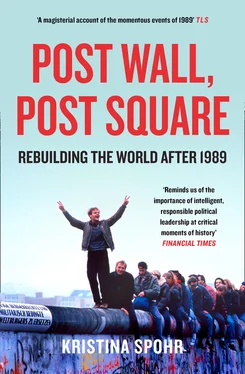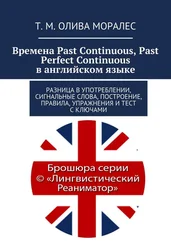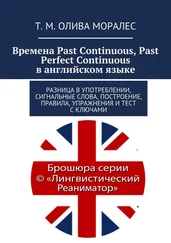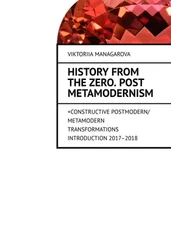But the very opposite happened: Honecker, ill and out of his depth, chose to box himself in. Just days before East Germany’s grand fortieth-birthday celebrations, he felt humiliated, even threatened. The stark images now flickering incessantly across TV screens of innumerable East Germans clambering over fences, besieging trains, overrunning embassies and finally clenching their fists in triumph on West German soil were a glaring indictment of his government.[159]
On 3 October Honecker sealed off all of East Germany from the outside world, even the rest of the Warsaw Pact. This was an unprecedented act. Now, for the first time, the crossing of any of the GDR’s borders required both a passport, possessed by only a minority of citizens, and a specific permit for each trip – documentation that in the current circumstances was highly unlikely to be issued.[160] East Germans were really angry. With the autumn school holidays just around the corner, thousands of East Germans had booked trips either to or through Czechoslovakia. Now with passport- and visa-free travel suspended, they were stuck at the GDR–Czechoslovak border in Saxony. Consequently it was here that demonstrations became the largest anywhere in the GDR. And as the last vents closed, the East German state was turning into a pressure cooker.[161]
Ironically, between 1 and 3 October, yet another 6,000 East Germans had poured into the West German Prague embassy. In all, some 10,000 to 11,000 would-be escapees were in limbo in and around Prague. On a smaller scale similar scenes occurred in Warsaw. And so another series of sealed trains was hastily arranged – whose departure was followed avidly by a multitude of local and foreign TV companies as well as the international press. It took eight trains from Prague to Hof to clear the backlog in Czechoslovakia; two more, carrying 1,445 people, left Warsaw for Hanover.[162] During this latest transit operation, thousands of East Germans – now feeling like prisoners in their own state – flocked to the tracks and stations to watch what became known as ‘the last trains to freedom’. Many hoped to sneak aboard. The situation in Dresden became so fraught that police had use force to clear the station and tracks – overrun by some 2,500 people – and the doors of trains were sealed from the outside. It took until the early hours of 5 October to get three of the trains through Dresden Hauptbahnhof. The rest had to be rerouted through other cities.[163]
Meanwhile, a mob of some 20,000 angry people were left milling around outside on Dresden’s Lenin-Platz (now Wiener Platz) and in the adjoining streets. Police and troops went in hard with rubber truncheons and water cannons to disperse the crowd; the demonstrators fought back, hurling paving stones at the police, in what observers called the worst outbreak of civil disobedience since 1953.[164]
The East German security forces did their rough stuff under the watchful eye of officials from Dresden’s outpost of the Soviet KGB. It may well be that one of them was a young special officer by the name of Vladimir Vladimirovich Putin. As a KGB man, Putin sympathised with Honecker and his crackdown on state-traitors. What most disturbed him – as we know from later statements – was the deafening silence from his political superiors in Moscow. The call from the Kremlin never came: not one soldier of the Red Army was deployed to help the East German comrades reimpose order. The truth was that Gorbachev despised the ailing Honecker and his Stalinist henchmen; totally committed to his mission as a reformer, the Soviet leader abandoned this atrophied country that had no intention of renewing itself. His aide Anatoly Chernyaev lamented in his diary the ‘terrible scenes’ of violence damaging the East German and Soviet regimes alike. The brutal scenes in Dresden, played out in the media, only worsened the split between Honecker and Gorbachev, between East Berlin and its Soviet patron.[165]
By contrast, Honecker – fed up with the man in the Kremlin – turned to another communist ally: the People’s Republic of China. In June his regime expressed effusive support for Beijing’s use of force. The way Deng Xiaoping’s China had simply crushed the ‘counter-revolutionary unrest’ in Tiananmen Square was in Honecker’s mind an example to the whole bloc and a ray of hope for the future of real socialism, given Gorbachev’s failure to slap down protest and subversion.[166] The summer had shown how, as a direct result of the USSR stepping back, the Polish and Hungarian contagion of liberalisation was spreading across Eastern Europe. It had infected the GDR itself, causing first a haemorrhage of people and now, as Dresden demonstrated, unrest on the streets in the once-secure police state. Amid this domestic upheaval, the GDR was determined to shore up the international image of communism. That’s why Honecker sent Egon Krenz, his number two, on a high-profile week-long visit to Beijing, to celebrate the PRC’s fortieth anniversary on 1 October 1989, just days before the GDR’s own fortieth-birthday party. This was definitely a time for solidarity among true communists.
Throughout his trip, Krenz was eager to learn from the Chinese communist leadership about how to deal with protestors and reinforce the status quo.[167] Talking with party secretary Jiang Zemin on 26 September, Krenz expressed his pleasure in visiting an ‘impenetrable bastion of socialism in Asia’ where ‘under the leadership of the Communist Party, the most populous country in the world was freed from its half-colonial chains’. Jiang and Krenz agreed that the events of June 1989 had revealed the true hostile intent behind the Western strategy of ‘so-called peaceful evolution’ in relations with China, exposing it as ‘an aggressive programme of undermining socialism’.[168] Qiao Shi, another top CCP Politburo member and a key figure in implementing martial law, impressed on Krenz how closely he and his colleagues were following events in Europe, especially ‘developments in Poland and Hungary’. While these were a source of alarm, Qiao voiced great satisfaction at the East German refusal to take the same path and his resolve to ‘hold on to socialism’. After all, ‘we are all communists, our life consists of struggle’ – in ‘politics, ideology and the economy’.[169] The Paramount Leader Deng Xiaoping told Krenz emphatically ‘We defend socialism together – you in the GDR, we in the People’s Republic of China.’[170] Krenz in turn declared: ‘In the struggles of our time, the GDR and China stand side by side.’[171] They saw themselves as two beacons of socialism, shining out in a darkening and hostile world.
Krenz was one of very few VIPs on the strikingly meagre official list of foreigners to grace the PRC’s fortieth-anniversary festivities. The rest were minor figures from relatively marginal countries – a Czechoslovak Politburo member, a Cuban Communist Party official and Cabinet ministers from Ecuador and Mongolia. The Soviet Union was represented by the deputy chairman of the Soviet–Chinese Friendship Society. Largely because of international outrage about the 4 June events, no heads of government had come to take part. Even many ambassadors – from the United States, Canada, Western Europe and Japan – stayed away. Krenz, as deputy to the head of a major communist state in Europe, together with his North Korean counterpart Vice President Li Jong-ok, was the most senior foreign friend to sit with the ageing Chinese elite on the rostrum as they looked out over the restored tranquillity of Tiananmen Square. As Deng told Li, ‘When you go home, please tell President Kim Il-sung that China’s social order has returned to normal … What happened in Beijing not long ago was bad, but in the final analysis it is beneficial to us, because it made us more sober-minded.’ Li replied, ‘I am sure President Kim will be very happy about this.’[172]
Читать дальше












